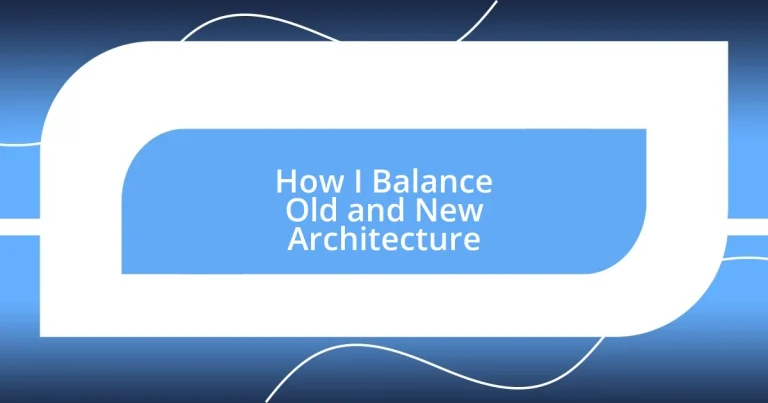Key takeaways:
- Old architecture serves as a cultural time capsule, holding stories and fostering community identity.
- Integrating old and new structures requires careful consideration of key features such as materials, scale, and community input.
- Sustainable practices enhance both historical integrity and emotional connections within architectural design, bridging the past with modern needs.

Understanding Old Architecture Importance
Old architecture is like a time capsule, holding stories and traditions that connect us to our past. I remember visiting a centuries-old church once, feeling the weight of history in the air. It’s fascinating how each stone and beam can evoke such a sense of belonging and continuity in our rapidly changing world.
When I walk through historic districts, I often wonder what life was like for the people who inhabited those spaces. The intricate details of façades and the craftsmanship of old buildings reveal not just artistic skill, but also the values and priorities of an era. It’s a reminder that architecture isn’t just about aesthetics; it’s a living testament to cultural identity.
Moreover, preserving old architecture fosters a deep respect for craftsmanship and sustainable practices. I’ve seen how repurposing these structures can breathe new life into communities, creating a vibrant blend of the old and new. It raises the question: how can we innovate while still honoring the beauty of what came before?

Identifying Key Architectural Features
Identifying key architectural features is essential when balancing old and new designs. I often find myself captivated by the ornate cornices or the curved arches of historical buildings; these details are like fingerprints that tell a story. When I design new structures, I take special care to integrate similar elements that resonate with the existing architecture. This way, I ensure that the new complements the old rather than competes against it.
To effectively identify features that should be preserved or incorporated, I tend to focus on:
- Materials: Traditional materials like brick, stone, or wood often offer a unique texture that modern materials can’t replicate.
- Lines and Shapes: Distinctive arches or gables help maintain the visual language of the area.
- Color Palettes: Utilizing colors found in the older architecture can create a harmonious blend.
- Ornamental Details: Features such as moldings, friezes, and balustrades add character and historical depth.
- Scale and Proportions: Ensuring new buildings respect the height and volume of the older ones can enhance visual coherence.
By recognizing these features, I feel more equipped to strike that delicate balance, creating spaces that foster connection while celebrating both heritage and innovation.

Strategies for Seamless Integration
When integrating old and new architecture, I often rely on the concept of dialogue between the two. I remember designing a modern extension to an 18th-century cottage, where the goal was to create a conversation rather than a clash. I chose glass for walls, allowing natural light to intertwine with the warm, rustic stone. It brought a fresh perspective while still respecting the historical backdrop, showing how seemingly contrasting elements can harmonize beautifully.
Another strategy I find effective is to focus on scale and rhythm. During a project in a small town, I observed how the heights and proportions of buildings played a crucial role in maintaining a cohesive streetscape. By ensuring that my new designs echoed the dimensions of the historic structures nearby, I was able to create a seamless flow, allowing passersby to transition smoothly through time. It’s gratifying to see how thoughtful consideration of scale enhances the overall aesthetic.
Lastly, I can’t stress enough the importance of involving the community in the design process. When I worked on revitalizing a public square, gathering input from local residents made a profound difference. Their stories and memories shaped the new features, making the space feel like an extension of their history while embracing modern needs. This synergy can only be achieved when we prioritize collaboration, ensuring that the new additions resonate with the past.
| Strategy | Description |
|---|---|
| Dialogue | Create a conversation between old and new elements. |
| Scale and Rhythm | Maintain cohesive street aesthetics by matching dimensions. |
| Community Involvement | Engage local residents to shape design and foster connection. |

Maintaining Historical Integrity
Maintaining historical integrity in architecture is a delicate endeavor that calls for deep respect and understanding of the past. I recall walking through a charming town where every building seemed to narrate its own story. The thought struck me: how can we create something new yet still honor the legacy of what’s already standing? It’s an ongoing conversation that must breathe life into every design decision I make.
In my experience, one of the most rewarding aspects of preservation is witnessing the emotional attachments people have to historical structures. I once visited a historic library slated for renovation, and as I listened to community members share their cherished memories tied to its grand columns and intricate woodwork, I realized these buildings hold more than bricks and mortar; they carry stories. This reinforces my belief that maintaining historical integrity isn’t just an obligation—it’s a way to recognize and celebrate the collective memories of a community.
It’s also crucial to consider how modern interventions can either enhance or undermine historical narratives. During a project where I had to blend a contemporary office building with an old factory, I made the bold choice to incorporate remnants of original factory materials into the new façade. This choice sparked conversations amongst team members and locals alike about preserving character while looking ahead. Can new structures serve as a bridge that connects our past and future? I wholeheartedly believe they can, if we approach the design process with intention and a heart open to history.

Utilizing Sustainable Practices
In my practice, embracing sustainable materials is a key consideration for blending old and new architecture. I recall a project where we decided to use reclaimed wood, which not only reduced waste but also added warmth and character to a contemporary home extension. The homeowners were thrilled; they felt connected to the history of the material, enriching their space with stories woven into each beam. Isn’t it fascinating how sustainability can foster emotional connections?
When it comes to energy efficiency, I’ve learned that integrating modern technologies with historic buildings can be a game changer. For instance, I once retrofitted an older commercial space with solar panels, artfully hidden beneath a green roof. Not only did it blend seamlessly with the existing architecture, but it also inspired neighboring businesses to consider similar upgrades. This raised a question in my mind: Can sustainable choices also elevate the appeal of heritage sites in the eyes of the community? It’s a beautiful thought that both preserves and revitalizes, breathing new life into our built environment.
Moreover, using eco-friendly practices goes beyond materials; it’s about creating spaces that foster well-being. I once designed a public park that included native plants and rain gardens to manage stormwater efficiently. The sense of community it engendered was palpable. Families gathered, children played, and local wildlife thrived. This experience reaffirmed my belief that sustainable practices don’t just benefit the environment; they enrich the social fabric of our surroundings. How can we continue to innovate while honoring our roots? That’s the exciting challenge I embrace every day.

Case Studies of Successful Balance
One remarkable case study that stands out in my mind is the transformation of a mid-century modern building into a vibrant community center. Working with a local nonprofit, we decided to preserve the structure’s unique lines and extensive glass elements, allowing natural light to flood the space. This design choice not only maintained its architectural integrity but also fostered a sense of inclusion and openness, inviting locals to feel connected to their heritage. The feedback from visitors was overwhelmingly positive—people shared how the space felt both familiar and refreshingly new.
Another example that truly resonated with me was a renovation project of a historic church where I incorporated contemporary stained-glass windows alongside the original ones. This juxtaposition sparked discussions about tradition versus innovation. The community embraced this blend, realizing it wasn’t just about preserving the past but also about embracing the future. I remember standing outside, soaking in the colors dancing on the church walls, and it hit me: isn’t it inspiring to think that architecture can evoke emotion and encourage dialogue across generations?
In a more intimate setting, I once worked on revamping a small café nestled in a historic district, where the goal was to maintain the façade’s charm while updating the interior. We opted for a minimalist design that showcased the vintage elements—exposed brick and antique fixtures—while infusing modern comforts. The owners loved the result; they shared how customers often commented on the café’s nostalgic feel. It made me wonder: can our spaces become a canvas that paints both the old and the new, telling a story worth sharing? I truly believe they can, and this project stands as a testament to that concept.














